![Golden Camel-7A [Mutant Camel]](picts/Mutant Camel_logo1.jpeg) |
|
|
monophonic analogue
transistor tablehooter
"toot... toooot... What the beep
is that?" |
|
|
|
We now proudly present you -
the likely worst keyboard of all times!... ???
This thing was initially rather a fraudulent prop
than a serious keyboard instrument, and the mechanical construction with
its cable mess looks very much like assembled in a Chinese concentration
camp, therefore don't buy a new one of these unless you really know what
you are doing and that you still want it. If any instrument really deserves
the term "tablehooter", then this loudly tooting plastic mock-up.
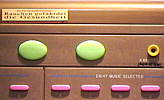 These drumpads are fake and only beep..
These drumpads are fake and only beep.. |
 Here you can see the extremely wacky keys of this thing.
Here you can see the extremely wacky keys of this thing. |
 The box shows a different variant with black case.
The box shows a different variant with black case. |
Although this looks like a modern digital stereo
keyboard, its tone generator is only a monophonic tooting transistor circuit
with vibrato in the technical standard of a 1970th toy organ. Its sound
can be compared best with a Stylophone. The only modern part is
a monophonic melody IC (COB module) that sounds worse than most melody
greeting cards. But the analogue hardware is well suited for circuit bending;
with some modifications you can get a lot of bizarre buzzy analogue electro
noises out of it.
On the package box of this instrument is a picture
of a black case version with the model name "SUNNY". A black case
variant of this instrument was also released as MS-7A and MS-8A
by
Yongmei (brand label was too blurred, but seen on the Yongmei
site).
main features:
-
flimsy golden metallic, semi-transparent plastic
case in the style of a modern stereo keyboard (but with only one speaker
inside); it has a white logo with camel and pyramids (blatantly copied
from "Camel" cigarette packages).
-
very flimsy 44 mid size keys (with a row of likely
hand- bent and soldered very crude tin leaf switches and resistors underneath).
-
transistorized monophonic sawtooth (?) tone generator
(without envelope) on a 1970th style analogue PCB.
-
switch for 2 timbres (pitch changes slightly when
switching it)
-
switch for 2 volume settings (terribly loud, and
louder!)
-
vibrato switch.
-
12 (?) demo melodies monophonic squarewave melody
IC (without envelope) that sounds worse (!) than average electronic melody
greeting cards.
-
mock up of a control panel with lots of alphabetic
labelled buttons those look like sound/ rhythm stuff or similar, but they
are all wired parallel and just select the next demo melody from the melody
chip.
-
a "play/ store" switch switches between keyboard
play and demos
-
3 fake drumpad button mock ups those only play keyboard
notes
-
microphone jack
-
power supply jack originally wired parallel (!) to
the battery compartment =>batteries may EXPLODE when using an AC adapter
without removing them.
modifications:
-
AC adapter jack re-wired correctly, voltage regulator
and sound output cinch jack added.
-
real volume control pot added.
-
3 sound manipulation pots added; they change pitch
and can make some bizarre, buzzy, partly almost voice- like wah- wah noises
when turned during the play of notes.
-
"play/ store" switch re-wired to enable the melody
IC to play simultaneously with the keyboard.
-
semi-transparent case upgraded with a green LED below
the keys and an orange one under the camel logo. Modified pictures from
"Camel" lung torpedo box added to the rear side and painted with the logo
"MUTANT CAMEL".
 |

These are the knobs I added. |
 |
notes:
In the (once widespread) class of monophonic transistor
toy organs with vibrato this thing is unique because with 44 keys it is
one with the longest keyboard. The modified instrument can make lots of
very buzzy and thin low tones (well suitable for "Flat Beat" style electro
musics) and especially when an unregulated AC adapter is set below the
necessary voltage of my voltage regulator, the instrument modulates all
tones with mains hum which adds to them an even more rough and buzzy appeal.
This tablehooter sounds very unique and its creaky bass sounds have little
similarity with nowadays average synthesizers (nor with TB303). The most
similar sounding professional instrument I found is the historical monophonic
tube keyboard Jörgensen Clavioline
(although the latter can do many other timbres due to its filters and suboscillator).
Unfortunately the keys of my "Mutant Camel" are
very flimsy (and might easily crack off when accidentally bent upwards),
their leaf contacts often bend or tangle with cables and also the control
panel switches may fail by oxidation because they scratch around on bare
copper PCB traces (see Golden Camel-11AB
photos), though I would not describe it as anything remotely "stage proof".
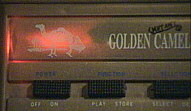 |
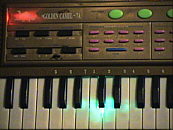 |
 Here you see how transparent the flimsy plastic is.
Here you see how transparent the flimsy plastic is. |
circuit bending details
These are some crude hand drawn schematics of the
Golden
Camel-7A and my modification:
 These
may be inaccurate or partly even wrong, but this is all I have about it.
The red components were added by me. These
may be inaccurate or partly even wrong, but this is all I have about it.
The red components were added by me.
|
A direct successor of the Golden Camel-7A
was released as Miles - Golden Camel-11AB,
which looks very similar but contains crude digital sound hardware instead.
Another 7A variant with rhythm chip (but likely still transistor
tooter main voice) was released as EGroovz Composer 1 (silver metallic
case, 4 red drumpads, 5 slide switches, made by K-Group
Industries, sold by Toys 'R ' Us for 19.95$), which on Amazon.com
got the worst destructive mocking critics thanks to its earbleeding loud
tone and fragile construction. Other variants of the Golden Camel-7A
(usually with less keys) were sold under many different brand names; e.g.
a 24 keys variant has the name "Panashiba PS-100" and a 37 keys
one "Jia Yin JY-3712A" and there are many others. Keyboards of this
analogue tooting transistor hardware class can be recognized without hearing
them by their lots of buttons labelled with alphabet letters and especially
a "play/ store" slide switch; often there are also other slide switches
labelled with alphabet letters. Also 3.5 mm microphone/ AC- adapter jacks
with a strange (usually yellow) plastic rim are a typical feature.
The genuine manufacturer of all these wacky tablehooters
seems to be the obscure Chinese company Yongmei (see here
for their internet site); according to their proudly boasting "about us"
page, their keyboard factory subsidiary is Meisheng, which uses
only imported ICs and makes no own ones. The model names of their instruments
often begin with "YM-" (=Yongmei), "MS-" (= Miles, MeiKe,
MeiSheng) or "JY-" (=Jia Yin), but there are also others.
A more complete list is here.
| Here are some eBay
photos of other keyboards in the Yongmei transistor tooter hardware
class. (I don't own these.) As usual, colours and "brand" names of all
these case variants vary a lot. (I guess in this case the manufacturers
know well why to change their name regularly - there must be an awful lot
of angry customers around now those certainly never want to buy such a
tablehooter again nor will recommend anybody else again to buy them...)
Also the demo melody chips seem to vary.
|
This one is the definitely most bizarre and top
of the line model of the Yongmei transistor tooter hardware class
(see above), because this huge monophonic
tablehooter has indeed 54 fullsize keys, a flashing light bulb, 4 OBS rhythms
and even a real rhythm tempo slider (controls simply the rhythm chip clock
rate) despite its main voice can only produce a very loud monophonic beep
with vibrato. Additionally it contains a chip with 4 sample based preset
rhythms. The instrument was released by Kamichi (not "Kamico" as
I thought first) and another one was named XH-210 (both seen on
eBay),
but my specimen is missing the box and has no brand label at all.
I guess that this loudly tooting plastic monster
will likely become rare in sooner future, because I really don't want to
imagine how many annoyed owners, parents or listeners will finally smash
them - considering them a mock-up or nasty novelty hoax. Also for a professional
stage keyboarder it must be a strange "Candid Camera" experience to get
spontaneously confronted on stage only with this "ersatz"- instrument in
an unexpected situation. Otherwise for a circuit bender the Kamichi
is certainly an interesting find, because it has a long keyboard, is less
fragile than the 7A, and with some mods you can get some really weird analogue
timbres out of Yongmei's transistor circuit.
I saw this thing first a decade ago on a flea
market in Bremen; it had the typical alphabet buttons and 5 circularly
arranged red buttons with rhythm names on them, but I didn't ask
for the price at that time, since I was carrying already much other stuff
and my den stands already plenty full of other keyboards and videogames.
Later someone demanded 10€ (too much) for such a thing. Years later
I finally bought mine on a flea market; it was in very bad condition with
many scratches, one speaker loose, several key hooks and a jack broken
and some cables torn off, but it costed only 1.50€. I am still not
sure if I have re-soldered all cables correctly back into place, because
the previous owner had connected at least the "play/ store" switch wires
wrongly (which disabled the melody chip).
main features:
-
big black plastic case with 2 speakers (wired parallel,
not stereo)
-
54 whacky fullsize keys (with a row of likely hand-
bent and soldered crude brass(?) leaf switches and resistors underneath).
-
switch for 2 volume settings (terribly loud, and
louder!)
-
7 timbres selectable through 3 "tone" switches (those
mix 3 differently filtered versions of the waveform together)
-
4 OBS preset rhythms (disco, swing= tango, chacha,
rumba); 1 button is a doublet
-
4 drumpad functions (through rhythm select buttons
when rhythm is off)
-
tempo slider (simply controls rhythm IC clock speed)
-
8 demo melodies on monophonic squarewave melody IC
"AI 71" (without envelope) that sounds worse (!) than average electronic
melody greeting cards.
-
mock up of a control panel ("computer select") with
lots of alphabetic labelled buttons those look like sound/ rhythm stuff
or similar, but they are all wired parallel and just select the next demo
melody from the melody chip.
-
a "play/ store" switch switches between keyboard
play and demos
-
transistorized monophonic sawtooth (?) tone generator
(without envelope) on a 1970th style analogue PCB; vibrato can not be turned
off.
-
separate small COB rhythm IC module "HGC5".
-
light bulb lamp (lights up during loud sounds)
-
battery compartment for 6 big C size batteries
-
microphone jack
-
power supply jack originally wired parallel (!) to
the battery compartment =>batteries may EXPLODE when using an AC adapter
without removing them.
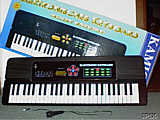 This
is an eBay picture. My specimen has different button colours and
lacks the original box and microphone. This
is an eBay picture. My specimen has different button colours and
lacks the original box and microphone. |
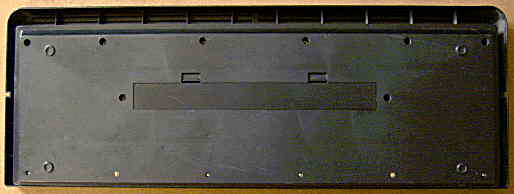
 |
 The "computer select" keypad is as fake as with the Golden Camel-7A.
The "computer select" keypad is as fake as with the Golden Camel-7A. |
eastereggs:
-
The "tone" switches slowly fade the timbre and volume
and thus provide a crude envelope effect when switched while notes are
played. Particularly switching from (0,1,0) to (0,0,1) mutes the sound
and makes it fade louder for 1 second. With all 3 switches off (i.e. down)
no sound is played. The switch settings also modify the rhythm timbre in
a similar way.
modifications:
-
AC adapter jack replaced and re-wired correctly
-
real volume control pot added (which also distorts
at low volume)
-
tempo potentiometer range extended
-
(I didn't upgrade this instrument more because I
already own my Mutant Camel,
but since it is analogue, it can be certainly modified similarly.)
notes:
The case shape (besides control panel) of this instrument
was likely modelled after some early 1990th designs of the Casio CTK
ToneBank series, and the lamp cover resembles much the one of the Animal
Keyboard toy instrument. The case and keyboard of the Kamichi
is a bit more robust than the fragile Golden
Camel-7A (and thus with some care certainly stage usable). In spite
of this the plastic hooks under 2 keys of mine were cracked off, thus I
fixed them with hotglue and a piece of thick insulated copper wire. The
tempo potentiometer slider made a bad contact with its metal contact trace,
thus I wired a soft wick cable to it to fix this. The main PCB has a different
shape than with the 7A, but the rest is technically very similar. A small,
dim light bulb flashes like a music light, but only during very loud sounds.
(Without my additional volume pot it always played quite loud, but possibly
the lamp just responds badly by confused cables.)
The electronics of the Kamichi is the same
horrible cable mess with unreliable 1970th toy style metal spring switches
like the Golden Camel-7A; there are multiple small and tiny PCBs
in it and the rhythm is generated by a tiny COB chip module. Unlike with
the 7A, the punched out keyboard leaf spring component is here either gold
or brass plated. I replaced the 2 step volume switch with a 100 kOhm potentiometer
(open end connected through 100µF cap against GND). The original
switch is bridged with a 20 kOhm resistor on the PCB, which needs to be
removed for this. (At low volume the sound distorts a bit with these components.
The now unused switch can be certainly re-wired to turn off vibrato).
This instrument has 4 sample based rhythms, those
select buttons also work as drumpads when no rhythm is played. 1 of the
5 rhythm select buttons is fake (wired parallel with another), thus there
are only 4 rhythms and they also have no similarity with the button labels.
I therefore have written down the 4 real rhythm patterns here:
| button label |
drumpad sound |
real rhythm pattern |
| disco |
cymbal [c] |
[b-sss-s-b-b-t-t-] |
| swing, tango |
snare [s] |
[b-b-s-b-] (rock) |
| chacha |
tom [t] |
[c--cc---] (swing made from cymbal only) |
| rumba |
base [b] |
[b---b---b---bsss] (4beat with drumroll,
majestic march?) |
The 4 rhythms of this instrument are identical
with the ones of the "Dancing Skull" sound toy (a walking white
plastic skull with green flashing LED eyes, made in China by Goldlok),
but not with with the similar chip of my Golden
Camel-11AB. Due to this abused toy chip has no tempo control, the
manufacturer wired the tempo pot the classic circuit bender's way. The
clock input of the chip is AC controlled (HF at the potentiometer) and
it can be overclocked until the rhythm turns into a continuous beep (by
replacing the 75 kOhm resistor in the clock line with 1 kOhm and removing
the 100 kOhm resistor between wiper and "+" pot end and pulling the "-"
pot end through a 220k preset trimmer against the +3Vs of the IC). But
at least with my specimen the rhythm stops when underclocked too much.
The rhythm CPU has 2 unused pins (possibly output for LED flash effects).
 This smaller 44 midsize keys variant of the big Kamichi was also
released under the Golden Camel label. Also a version with blue
and yellow buttons came out as "ITEM NO. 10A". (I saw it on eBay
but don't own it.)
This smaller 44 midsize keys variant of the big Kamichi was also
released under the Golden Camel label. Also a version with blue
and yellow buttons came out as "ITEM NO. 10A". (I saw it on eBay
but don't own it.) |
Someone e-mailed me that another transistor tooter
with the same rhythm chip was the Yongmei YM-398B (37 keys, grey
case?, mains operated).
transition Yongmei
keyboards
The company Yongmei
(or Meisheng) apparently first built only their infamous transistor
tooters (with monophonic analogue transistor tone generator, incredible
cable mess and sheet metal contacts inside, see above).
Nowadays they make keyboards with fairly normal looking PCBs, (kind of)
silicone rubber contacts and digital single chip CPU. But in between there
was a short intermediate period where Yongmei made keyboards with already
a digital sound generator chip but still the case style and cable mess
of their former transistor tooters; these can be recognized because they
still have multiple slide switches but typically already real preset sound
and rhythm names instead of alphabet letters on their button fields. These
"transition Yongmeis" were produced only for a very short time and thus
are the rarest of all Yongmei keyboards (including e.g. Golden
Camel-11AB, Yongmei
MS-110A, Yongmei MS-210B,
MeiKe
MK-320B, Yongmei MS-200 and Yongmei YM-378D). But
also the larger transistor tooters will likely become rare soon, since
by fragility and ear tormenting loud tooting they will certainly not survive
parental rage attacks and end smashed in trashcans as quickly as they were
assembled together (a fate that also decimated the legions of wacky late
1980th boomboxes). Nowadays
Yongmei makes beside horrible yelling
toy squeakboxes even professional MIDI keyboards with LCD and 61 velocity
sensitive fullsize keys, but I have not heard any of these yet. (Possibly
they contain Medeli hardware.) On
eBay
I also saw many semi- professional Yongmei sound bank keyboards with fullsize
keys; by their case design they are likely made by the same manufacturer
like the Sankai keyboards (see
here).
But at least the ones I bought are still ridiculously bad and full of flaws
(see e.g. Yongmei DL-2300,
YM-3300,
YM-6700).
| removal
of these screws voids warranty... |
|
|
 |

|
|
| |
back
|
|

 These drumpads are fake and only beep..
These drumpads are fake and only beep.. Here you can see the extremely wacky keys of this thing.
Here you can see the extremely wacky keys of this thing. The box shows a different variant with black case.
The box shows a different variant with black case.




 Here you see how transparent the flimsy plastic is.
Here you see how transparent the flimsy plastic is.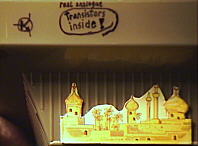


 This
is an eBay picture. My specimen has different button colours and
lacks the original box and microphone.
This
is an eBay picture. My specimen has different button colours and
lacks the original box and microphone.
 The "computer select" keypad is as fake as with the Golden Camel-7A.
The "computer select" keypad is as fake as with the Golden Camel-7A. This smaller 44 midsize keys variant of the big Kamichi was also
released under the Golden Camel label. Also a version with blue
and yellow buttons came out as "ITEM NO. 10A". (I saw it on eBay
but don't own it.)
This smaller 44 midsize keys variant of the big Kamichi was also
released under the Golden Camel label. Also a version with blue
and yellow buttons came out as "ITEM NO. 10A". (I saw it on eBay
but don't own it.)